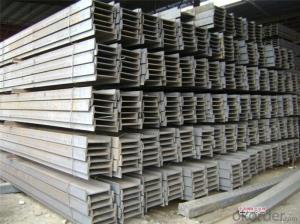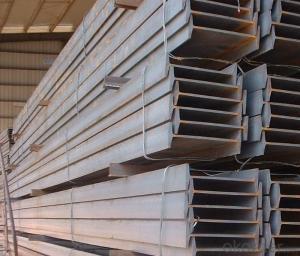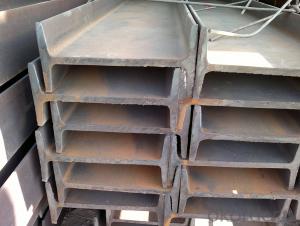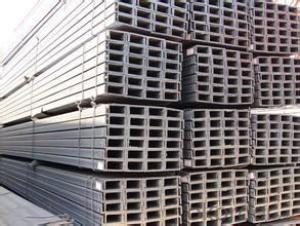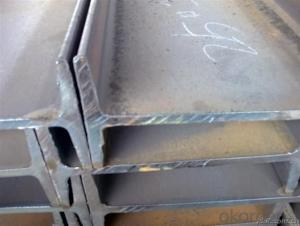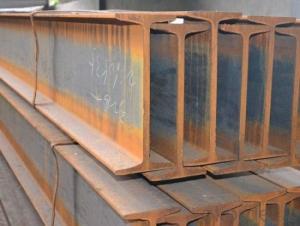Hot Rolled IPE and IPEAA Beams in Q235B Grade with Good Price
- Loading Port:
- Tianjin
- Payment Terms:
- TT or LC
- Min Order Qty:
- 25 m.t.
- Supply Capability:
- 10000 m.t./month
OKorder Service Pledge
OKorder Financial Service
You Might Also Like
Product Applications:
Hot Rolled Steel I-Beams are ideal for structural applications and are widely used in the construction of buildings and bridges, and the manufacturing, petrochemical, and transportation industries.
Product Advantages:
OKorder's Steel I-Beams are durable, strong, and resist corrosion.
Main Product Features:
· Premium quality
· Prompt delivery & seaworthy packing (30 days after receiving deposit)
· Corrosion resistance
· Can be recycled and reused
· Mill test certification
· Professional Service
· Competitive pricing
Product Specifications:
Manufacture: Hot rolled
Grade: Q195 – 235
Certificates: ISO, SGS, BV, CIQ
Length: 6m – 12m, as per customer request
Packaging: Export packing, nude packing, bundled
Chinese Standard (H*W*T) | Weight (Kg/m) | 6m (pcs/ton) | Light I (H*W*T) | Weight (Kg/m) | 6m (pcs/ton) | Light II (H*W*T) | Weight (Kg/m) | 6M |
100*68*4.5 | 11.261 | 14.8 | 100*66*4.3 | 10.13 | 16.4 | 100*64*4 | 8.45 | 19.7 |
120*74*5.0 | 13.987 | 11.9 | 120*72*4.8 | 12.59 | 13.2 | 120*70*4.5 | 10.49 | 15.8 |
140*80*5.5 | 16.89 | 9.8 | 140*78*5.3 | 15.2 | 10.9 | 140*76*5 | 12.67 | 13.1 |
160*88*6 | 20.513 | 8.1 | 160*86*5.8 | 18.46 | 9 | 160*84*5.5 | 15.38 | 10.8 |
180*94*6.5 | 24.143 | 6.9 | 180*92*6.3 | 21.73 | 7.6 | 180*90*6 | 18.11 | 9.2 |
200*100*7 | 27.929 | 5.9 | 200*98*6.8 | 25.14 | 6.6 | 200*96*6.5 | 20.95 | 7.9 |
220*110*7.5 | 33.07 | 5 | 220*108*7.3 | 29.76 | 5.6 | 220*106*7 | 24.8 | 6.7 |
250*116*8 | 38.105 | 4.3 | 250*114*7.8 | 34.29 | 4.8 | 250*112*7.5 | 28.58 | 5.8 |
280*122*8.5 | 43.492 | 3.8 | 280*120*8.2 | 39.14 | 4.2 | 280*120*8 | 36.97 | 4.5 |
300*126*9 | 48.084 | 3.4 | 300*124*9.2 | 43.28 | 3.8 | 300*124*8.5 | 40.87 | 4 |
320*130*9.5 | 52.717 | 3.1 | 320*127*9.2 | 48.5 | 3.4 | |||
360*136*10 | 60.037 | 2.7 | 360*132*9.5 | 55.23 | 3 |
FAQ:
Q1: Why buy Materials & Equipment from OKorder.com?
A1: All products offered byOKorder.com are carefully selected from China's most reliable manufacturing enterprises. Through its ISO certifications, OKorder.com adheres to the highest standards and a commitment to supply chain safety and customer satisfaction.
Q2: What makes stainless steel stainless?
A2: Stainless steel must contain at least 10.5 % chromium. It is this element that reacts with the oxygen in the air to form a complex chrome-oxide surface layer that is invisible but strong enough to prevent further oxygen from "staining" (rusting) the surface. Higher levels of chromium and the addition of other alloying elements such as nickel and molybdenum enhance this surface layer and improve the corrosion resistance of the stainless material.
Q3: Can stainless steel rust?
A3: Stainless does not "rust" as you think of regular steel rusting with a red oxide on the surface that flakes off. If you see red rust it is probably due to some iron particles that have contaminated the surface of the stainless steel and it is these iron particles that are rusting. Look at the source of the rusting and see if you can remove it from the surface.
Images:
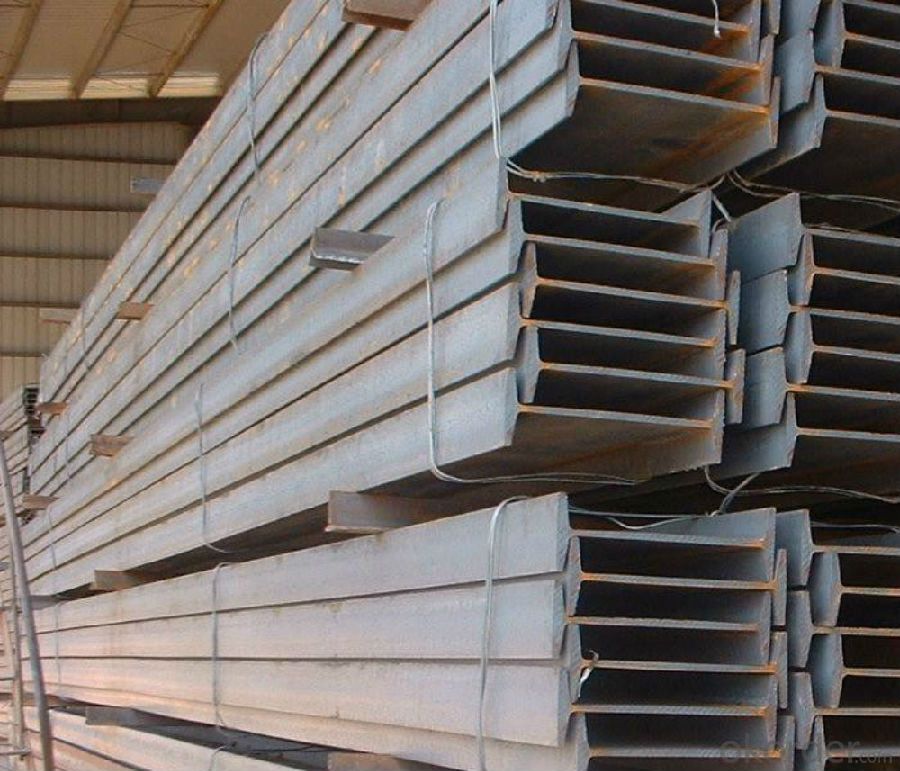
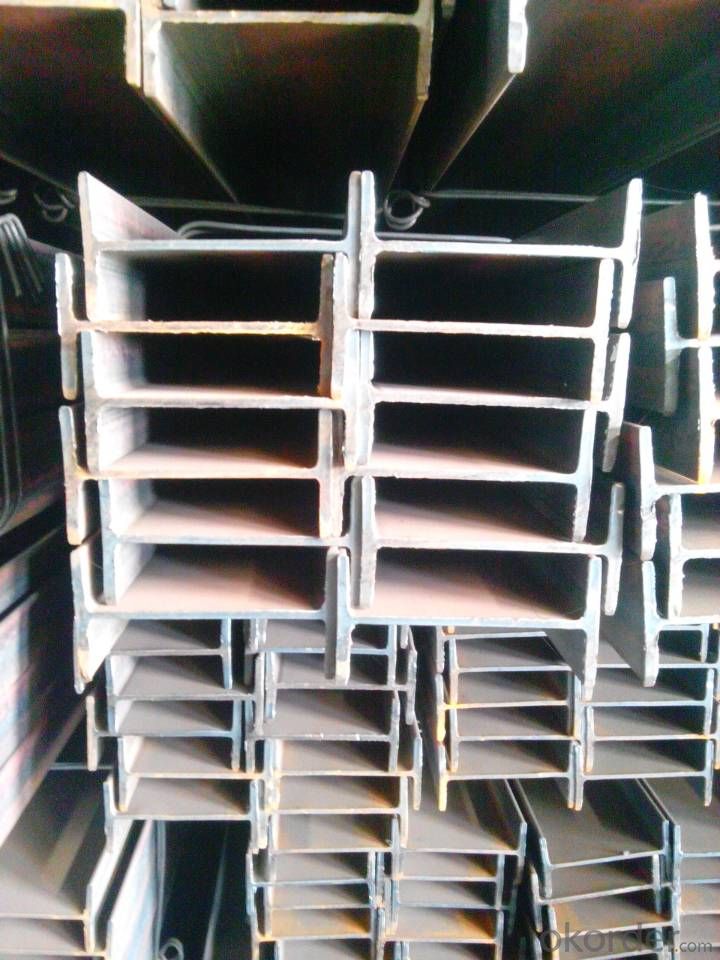
- Q:Can steel I-beams be used for architectural designs?
- Yes, steel I-beams can be used for architectural designs. Steel I-beams are commonly used in architecture due to their strength, durability, and versatility. They can support heavy loads, making them suitable for constructing large and complex structures such as bridges, high-rise buildings, and stadiums. The ability of steel I-beams to span long distances without the need for additional support columns allows for open and flexible floor plans, making them ideal for modern architectural designs. Additionally, steel I-beams can be fabricated to various sizes and shapes, providing architects with the freedom to create unique and innovative designs. The use of steel I-beams in architectural designs also offers advantages in terms of cost-effectiveness, sustainability, and fire resistance. Overall, steel I-beams are a popular choice in architectural designs due to their strength, versatility, and aesthetic appeal.
- Q:Standard for welding quality of I-beam
- I-beam is mainly divided into ordinary I-beam, light I-beam and H steel three.Ordinary I-beam, light I-beam flange is variable cross-section, depending on the thickness of the web, the external thin; H steel: HW, HM, HN, HEA, HEB, HEM and so on, the flange of I-beam is a uniform sectionOrdinary I-beam, lightweight I-beam has formed the national standard, the common 10# I-beam is equivalent to the Internet I100 (such as 10# also channel equivalent channel (U100) for the implementation of the standards of different countries, which have subtle differences in their specifications)H type I-beam is also called wide flange I-beam, HW, HM, HN originated from European standards, HEB is the German standard of I-beam, of which HW, HN I-beam has been widely used in our country and production. HEA HEB HEM will be seen on many German designs and is hard to buy on the domestic market. In the domestic steel structure engineering, if the quantity is few, then may use the specification steel plate to carry on the welding splicing. In the case of large quantities, it is usually considered to use mechanical properties comparable to those of HW and HN steel.
- Q:Do steel I-beams require any special insulation or soundproofing measures?
- Steel I-beams do not typically require any special insulation or soundproofing measures. Steel is a highly dense and rigid material that naturally has good sound insulation properties. Additionally, I-beams are usually used in structural applications where soundproofing is not a primary concern, such as in the construction of buildings, bridges, or other large structures. However, in certain cases where noise reduction is important, such as in recording studios or theaters, additional soundproofing measures may be taken, but these measures would typically involve adding insulation or soundproofing materials to the surrounding walls, ceilings, or floors, rather than directly to the steel I-beams themselves.
- Q:How do steel I-beams perform in terms of electromagnetic interference (EMI) shielding?
- Steel I-beams are not effective in terms of electromagnetic interference (EMI) shielding. Steel is a good conductor of electricity, which means it can actually amplify electromagnetic interference rather than shielding it. To effectively shield against EMI, materials with high magnetic permeability, such as mu-metal or certain alloys, are typically used.
- Q:Can steel I-beams be used in airport terminal construction?
- Indeed, airport terminal construction does make use of steel I-beams. These beams, renowned for their strength and durability, are widely employed in the construction industry. They offer a robust framework capable of bearing heavy loads and enduring the structural requirements of extensive undertakings like airport terminals. Furthermore, steel possesses fire-resistant properties and can be conveniently fabricated and erected on-site, rendering it a pragmatic selection for projects with stringent timelines. By incorporating steel I-beams into airport terminal construction, the structure's safety and stability are assured, all the while permitting flexibility in design and construction approaches.
- Q:How do engineers determine the appropriate size of steel I-beams for a specific application?
- Engineers determine the appropriate size of steel I-beams for a specific application by carefully considering various factors such as the load requirements, span length, and safety standards. Firstly, engineers analyze the load requirements of the application, which includes both the dead load (the weight of the structure itself) and the live load (the weight imposed on the structure by the intended use). This helps in determining the maximum load that the steel I-beams need to bear. Next, engineers consider the span length, which is the distance between the supports that the steel I-beams will be placed on. Longer spans require larger beams to ensure they can resist bending and deflection. Once the load requirements and span length are determined, engineers refer to design codes and safety standards such as the American Institute of Steel Construction (AISC) Manual to select the appropriate section of the steel I-beam. These standards provide tables and formulas that help engineers determine the required moment of inertia and section modulus for the given loads and span length. Engineers also consider factors such as the type of steel material to be used, the desired level of structural rigidity, and any additional factors like fire resistance or vibration dampening. These considerations help in selecting the appropriate size and shape of the steel I-beam. Computer-aided design (CAD) software and structural analysis tools are often used to simulate and analyze the behavior of the steel I-beams under different loads and conditions. This enables engineers to fine-tune their selection and ensure the chosen I-beam size will meet the required safety factors, deflection limits, and other performance criteria. In summary, engineers determine the appropriate size of steel I-beams for a specific application by considering load requirements, span length, safety standards, material properties, and other factors. By carefully analyzing these factors and using design codes and software, engineers can confidently select the most suitable I-beam size to ensure structural integrity and safety.
- Q:Can steel I-beams be used in retail or commercial renovation projects?
- Yes, steel I-beams can be used in retail or commercial renovation projects. Steel I-beams are commonly used in construction due to their strength and load-bearing capabilities. They provide structural support and can be used to reinforce existing structures or create new openings in walls. Their versatility and durability make them suitable for various renovation projects in the retail or commercial sector.
- Q:Can Steel I-Beams be used for agricultural buildings?
- Yes, Steel I-Beams can be used for agricultural buildings. They are commonly used in agricultural construction due to their strength, durability, and versatility. Steel I-Beams provide excellent support for large spans, making them suitable for barns, storage sheds, and other agricultural structures that require wide open spaces. Additionally, steel is resistant to pests, rot, and fire, making it a practical choice for agricultural buildings that need to withstand harsh environmental conditions.
- Q:What are the different fabrication methods for steel I-beams?
- The different fabrication methods for steel I-beams include hot rolling, cold rolling, and welding. Hot rolling involves heating the steel billet and passing it through a series of rollers to shape it into an I-beam. Cold rolling is a similar process but is carried out at room temperature, resulting in a more precise final product. Welding involves joining individual steel plates or sections together to form the I-beam shape.
- Q:Can steel I-beams be used in the construction of office buildings?
- Yes, steel I-beams can be used in the construction of office buildings. Steel I-beams are commonly used as structural support elements in various types of buildings, including office buildings. They are known for their strength, durability, and load-bearing capacity, making them suitable for supporting the weight of the floors, walls, and roof of an office building. Steel I-beams are often used in the construction of skyscrapers, where their ability to withstand heavy loads and provide long-span support is crucial. Additionally, steel I-beams offer flexibility in design and can be easily integrated into the overall architectural layout of an office building. Their use in construction also allows for faster construction times and reduced costs compared to other structural materials. Overall, steel I-beams are a popular choice in the construction of office buildings due to their strength, reliability, and versatility.
1. Manufacturer Overview |
|
|---|---|
| Location | |
| Year Established | |
| Annual Output Value | |
| Main Markets | |
| Company Certifications | |
2. Manufacturer Certificates |
|
|---|---|
| a) Certification Name | |
| Range | |
| Reference | |
| Validity Period | |
3. Manufacturer Capability |
|
|---|---|
| a)Trade Capacity | |
| Nearest Port | |
| Export Percentage | |
| No.of Employees in Trade Department | |
| Language Spoken: | |
| b)Factory Information | |
| Factory Size: | |
| No. of Production Lines | |
| Contract Manufacturing | |
| Product Price Range | |
Send your message to us
Hot Rolled IPE and IPEAA Beams in Q235B Grade with Good Price
- Loading Port:
- Tianjin
- Payment Terms:
- TT or LC
- Min Order Qty:
- 25 m.t.
- Supply Capability:
- 10000 m.t./month
OKorder Service Pledge
OKorder Financial Service
Similar products
New products
Hot products
Hot Searches
Related keywords
